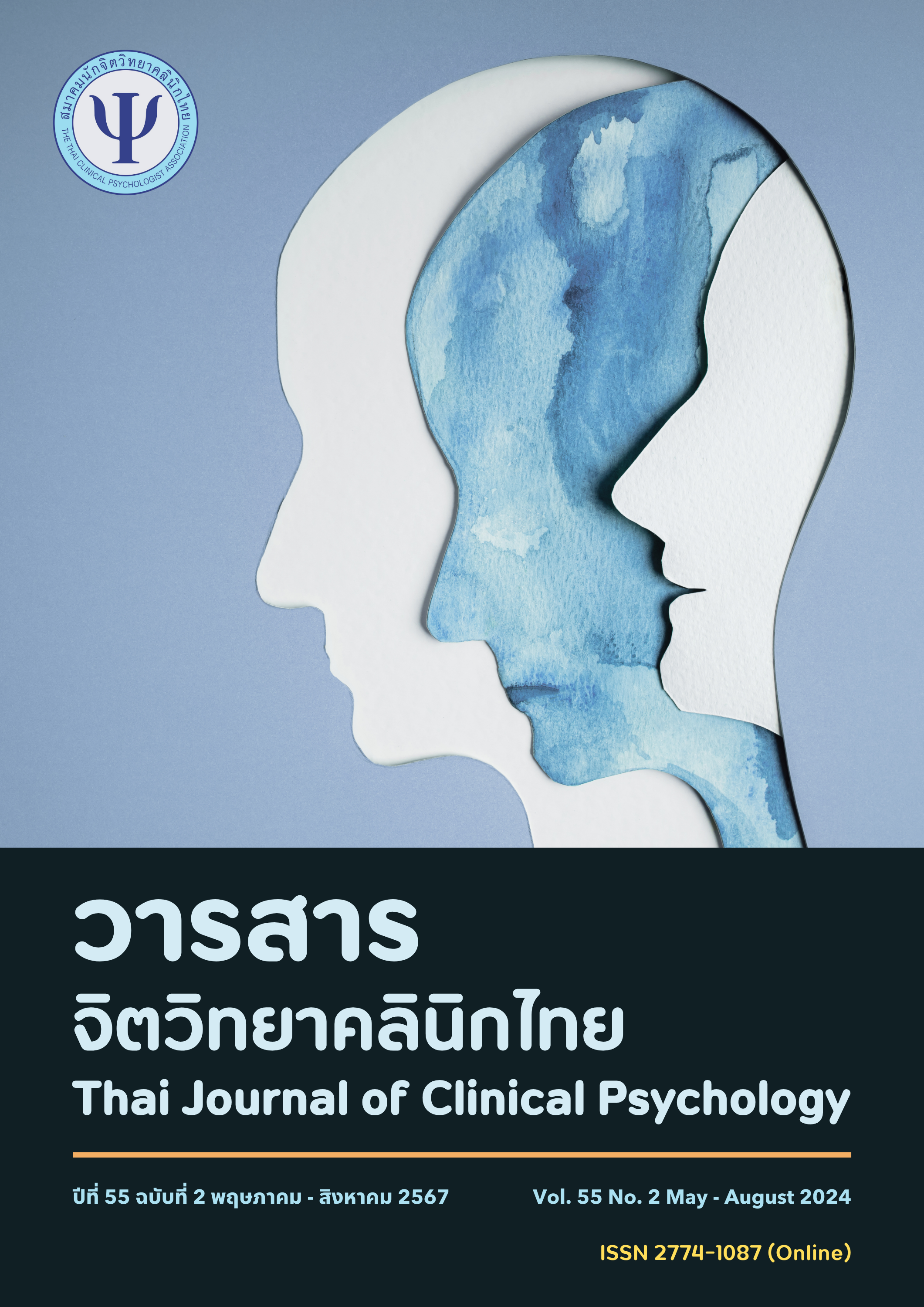The Development of the Social Cognition Assessment Tool for Psychiatric Rehabilitation of Chronic Schizophrenia Patients
Main Article Content
Abstract
Objectives: 1) To develop a Social Cognition Assessment Tool for Psychiatric Rehabilitation of Chronic Schizophrenia Patients (SCAT-CS) and 2) to examine psychometric properties of SCAT-CS. Materials and methods: This study employed research and development design. It was divided into 2 phases: 1) development of SCAT-CS, and testing of content validity, and 2) examination of construct validity and concurrent validity with standard psychological tests. The samples were 140 chronic schizophrenia patients, aged 18-59 years, receiving service at Srithanya Hospital in February 2024. Construct validity was analyzed using confirmatory factor analysis. Reliability was estimated by internal consistency using Cronbach’s alpha coefficients. Concurrent validity was tested with WAIS-III by Pearson’s correlation. Results: The first draft consisted of 31 items across 4 domains; 1) emotion perception 2) theory of mind 3) social perception, and 4) attributional bias. After examining content validity, twenty-two items were remained. Subsequently, item analysis retained 20 items. Cronbach's alpha coefficients are 0.86, 0.74, 0.80 and 0.72, respectively. Confirmatory factor analysis found that the model fit with empirical data. Concurrent validity found that every domain significantly correlated with Picture Arrangement, Picture Completion and Object Assembly subtests in WAIS-III. Conclusion: The SCAT-CS consisted of 4 domains including 20 items. These findings can support the psychometric properties, validity and reliability for using SCAT-CS for assessing social cognition in chronic schizophrenia patients. Further research for examining the cut-off point could be conducted.
Article Details

This work is licensed under a Creative Commons Attribution-NonCommercial-NoDerivatives 4.0 International License.
เรื่องที่ลงตีพิมพ์ในวารสารจิตวิทยาคลินิกแล้วถือเป็นลิขสิทธิ์การเผยแพร่โดยวารสารจิตวิทยาคลินิกแต่เพียงผู้เดียว การตีพิมพ์หรือเผยแพร่ซ้ำในที่อื่นต้องได้รับอนุญาตจากกองบรรณาธิการวารสารฯ
References
Allen, D. N., & Barchard, K. A. (2009). Identification of a social cognition construct for the WAIS-III. Applied Neuropsychology, 16(4), 262-74. https://doi.org/0.1080/09084280903297727.
Baron-Cohen, S., Jolliffe, T., Mortimore, C., & Robertson, M. (1997). Another advanced test of theory of mind: Evidence from very high
functioning adults with autism or Asperger syndrome. J Child Psychol Psychiatry, 38, 813-822.
Baron-Cohen, S., Wheelwright, S., Hill, J., Raste, Y, & Plumb, I. (2001). The “reading the mind in the eyes” test revised version: A study with normal adults, and adults with Asperger syndrome or high-functioning autism. J Child Psychol Psychiatry, 42(2), 241-51. https://pubmed.ncbi.nlm.nih.gov/11280420/
Charernboon, T., & Patumanond, J. (2017). Social cognition in schizophrenia. Ment Illn, 9(1), 7054. https://doi.org/10.4081/mi.2017.7054.
Corrigan, P. W., Silverman, R., Stephenson, J., Nugent-Hirschbeck, J., & Buican, B. J. (1996). Situational familiarity and feature recognition
in schizophrenia. Schizophr Bull, 22(1), 153-61. https://doi.org/10.1093/schbul/22.1.153
Corrigan, P. W., & Penn, D. L. (Eds.). (2001). Social cognition and schizophrenia. American Psychological Association. https://doi.org/
1037/10407-000
Division of Psychology. (2020). Handbook of group cognitive remediation for chronic schizophrenia [Unpublished manuscript]. Srithanya Hospital, Nonthaburi. (in Thai).
Fett, A. K. J., Viechtbauer, W., Dominguez, M.-deG., Penn, D. L., Os, J. V., & Krabbendam, L. (2011). The relationship between neurocognition and social cognition with functional outcomes in schizophrenia: A meta-analysis. Neurosci
Biobehav Rev, 35(3), 573-88. https://doi.org/0.1016/j.neubiorev.2010.07.001.
Green, M. F., Kern, R. S., Braff, D. L., & Mintz, J. (2000). Neurocognitive deficits and functional outcome in schizophrenia: Are we measuring the “right stuff”? Schizophrenia Bulletin, 26, 119-136. https://doi.org/10.1093/oxfordjournals. schbul.a033430.
Green, M. F., Penn, D. L., Bentall, R., Carpenter, W. T., Gaebel, W., Gur, R. C., Kring, A. M., Park, S., Silverstein, S.M., & Heinssen, R. (2008). Social Cognition in schizophrenia: An NIMH workshop on definitions, assessment, and research opportunities. Schizophrenia Bulletin, 34(6), 1211-1220. https://doi.org/10.1093/schbul/sbm145
Harvey, P. D., & Penn, D. (2010). Social cognition: The key factor predicting social outcome in people with schizophrenia? Psychiatry, 7, 41-44.
Horan, W. P., Kern, R. S., Shokat-Fadai, K., Sergi, M. J., Wynn, J. K., & Green, M. F. (2009). Social cognitive skills training in schizophrenia: An initial efficacy study of stabilized outpatients. Schizophrenia Research, 107(1), 4754. https://doi.org/10.1016/j.schres.2008.09.006
Horan, W. P., Green, M. F., DeGroot, M., Fiske, A., Hellemann, G., Kee, K. Kern, R.S., Lee, J., Sergi, M. J., Subotnik, K. L., Sugar, C. A., Ventura, J., & Nuechterlein, K. H. (2012). Social cognition in schizophrenia, Part 2: 12-month stability and prediction of functional outcome in firstepisode patients. Schizophr Bull, 38, 865-72. https://doi.org/10.1093/schbul/sbr001
Lotrakul, M., & Sukanit, P. (Eds). (2015). Ramathibodi’s essential of psychiatry (4th ed). Faculty of Medicine Ramathibodi Hospital. (in
Thai).
Pinkham, A. E., Penn, D. L., Green, M. F., Buck, B., Healey, K. & Harvey, P. D. (2014). The social cognition psychometric evaluation study:
Results of the expert survey and RAND panel. Schizophr Bull,40, 813-23. https://doi.org/10.1093/schbul/sbt081.
Pinkham, A. E., Penn, D. L., Green, M. F., & Harvey, P. D. ( 2016) . Social cognition psychometric evaluation: Results of the initial psychometric study. Schizophrenia Bulletin, 42(2), 494-504.https://doi.org/10.1093/schbul/sbv056
Polit, D. F., & Beck, C. T. (2006). The content validity index: Are you sure you know what’s being reported? Critique and recommendations. Research in Nursing & Health, 29(1), 489-497. https://doi.org/10.1002/nur.20147
Suksai, P., Sakulsriprasert, C., Supreeyaporn, N., & Potikul, S. (2023). Difficulties in emotion regulation and alcohol-related problems amongundergraduate students: The mediating role of drinking motives. Thai Journal of Clinical Psychology, 54(1), 1-11. https://so03.tcithaijo.org/index.php/tci-thaijclinicpsy/article/view/263565/177201
Swartz, M. S., Perkins, D. O., Stroup, S. T., Davis, S. M., Capuano, G., Rosenheck, R. A., Reimherr, F., McGee, M. F., Keefe, R. S. E., McEvoy, J. P., Hsiao, J. K., & Lieberman, J. A. (2007). Effects of antipsychotic medications on psychosocial functioning in patients with chronic
schizophrenia: Findings from the NIMH CATIE study. Am. J. Psychiatry, 164, 428-436. https://doi.org/10.1176/ajp.2007.164.3.428
Whiteford, H. A., Degenhardt, L., Rehm, J., Baxter, A. J., Ferrari, A. J., Erskine, H. E., Charlson, F. J., Norman, R. E., Flaxman, A. D., Johns, N.,
Burstein, R., Murray, C. J. L., & Vos, T. (2013). Global burden of disease attributable to mental and substance use disorders: Findings
from the global burden of disease study 2010. The Lancet, 382 (9904), 1575-1586.
WongRattana, C. (1998). Statistics application technique for research. Thepnimit Kan Pim. (in Thai)

